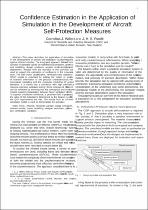 ResearchSpace
ResearchSpace
Confidence estimation in the application of simulation in the development of aircraft self-protection measures
JavaScript is disabled for your browser. Some features of this site may not work without it.
- ResearchSpace
- →
- Research Publications/Outputs
- →
- Conference Publications
- →
- View Item
| dc.contributor.author |
Willers, Cornelius J

|
|
| dc.contributor.author |
Roodt, JH

|
|
| dc.date.accessioned | 2011-10-13T11:12:24Z | |
| dc.date.available | 2011-10-13T11:12:24Z | |
| dc.date.issued | 2011-04 | |
| dc.identifier.citation | Willers, CJ and Roodt, JH. 2011. Confidence estimation in the application of simulation in the development of aircraft self-protection measures. Saudi International Electronics, Communications and Photonics Conference, Riyadh, Saudi Arabia, 23-26 April 2011 | en_US |
| dc.identifier.uri | http://hdl.handle.net/10204/5235 | |
| dc.description | Saudi International Electronics, Communications and Photonics Conference, Riyadh, Saudi Arabia, 23-26 April 2011 | en_US |
| dc.description.abstract | This paper describes the application of simulation in the development of aircraft self-protection countermeasures against infrared missiles. The integrated approach followed here consists of repeated cycles of materiel1 characterisation, analysis and modelling, design synthesis, solution implementation and deployment. Results from the activities in this workflow are used to support the estimation of confidence in the simulation tools. The well known Qualification, Verification and Validation (QVV) model is extended by adding the notion of quality of scenario information to the physical characterisation, the conceptual modelling and the computer modelling of system elements. It is shown that a simulation with high confidence requires extensive validation testing. Some measure of confidence can be achieved by ensuring that the conceptual and computer models support extrapolation between fewer validated ‘islands’. To express simulation confidence, a ‘potential field’ is proposed; the value of this potential is determined by the degree to which the QVV requirements are met. The results from an infrared simulation model is used to demonstrate this principle. | en_US |
| dc.language.iso | en | en_US |
| dc.relation.ispartofseries | Workflow request;7398 | |
| dc.subject | Infrared | en_US |
| dc.subject | Electronic warfare | en_US |
| dc.subject | Image simulation | en_US |
| dc.subject | Infrared missile | en_US |
| dc.subject | Scene modelling | en_US |
| dc.subject | Weapon evaluation | en_US |
| dc.subject | Photonics | en_US |
| dc.subject | Elctronics | en_US |
| dc.subject | Aircrafts | en_US |
| dc.title | Confidence estimation in the application of simulation in the development of aircraft self-protection measures | en_US |
| dc.type | Conference Presentation | en_US |
| dc.identifier.apacitation | Willers, C. J., & Roodt, J. (2011). Confidence estimation in the application of simulation in the development of aircraft self-protection measures. http://hdl.handle.net/10204/5235 | en_ZA |
| dc.identifier.chicagocitation | Willers, Cornelius J, and JH Roodt. "Confidence estimation in the application of simulation in the development of aircraft self-protection measures." (2011): http://hdl.handle.net/10204/5235 | en_ZA |
| dc.identifier.vancouvercitation | Willers CJ, Roodt J, Confidence estimation in the application of simulation in the development of aircraft self-protection measures; 2011. http://hdl.handle.net/10204/5235 . | en_ZA |
| dc.identifier.ris | TY - Conference Presentation AU - Willers, Cornelius J AU - Roodt, JH AB - This paper describes the application of simulation in the development of aircraft self-protection countermeasures against infrared missiles. The integrated approach followed here consists of repeated cycles of materiel1 characterisation, analysis and modelling, design synthesis, solution implementation and deployment. Results from the activities in this workflow are used to support the estimation of confidence in the simulation tools. The well known Qualification, Verification and Validation (QVV) model is extended by adding the notion of quality of scenario information to the physical characterisation, the conceptual modelling and the computer modelling of system elements. It is shown that a simulation with high confidence requires extensive validation testing. Some measure of confidence can be achieved by ensuring that the conceptual and computer models support extrapolation between fewer validated ‘islands’. To express simulation confidence, a ‘potential field’ is proposed; the value of this potential is determined by the degree to which the QVV requirements are met. The results from an infrared simulation model is used to demonstrate this principle. DA - 2011-04 DB - ResearchSpace DP - CSIR KW - Infrared KW - Electronic warfare KW - Image simulation KW - Infrared missile KW - Scene modelling KW - Weapon evaluation KW - Photonics KW - Elctronics KW - Aircrafts LK - https://researchspace.csir.co.za PY - 2011 T1 - Confidence estimation in the application of simulation in the development of aircraft self-protection measures TI - Confidence estimation in the application of simulation in the development of aircraft self-protection measures UR - http://hdl.handle.net/10204/5235 ER - | en_ZA |





